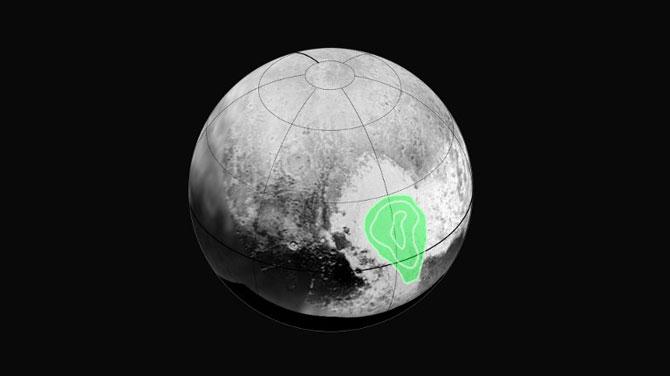A close-up image of Pluto has revealed a vast, craterless plain - resembling frozen mud cracks on Earth - that appears to be no more than 100 million years old and is still being shaped by geologic processes

This photo obtained from NASA July 17, 2015 shows a look at the â??heart of Pluto,â? in the western half of what mission scientists have informally named Tombaugh Regio (Tombaugh Region), New Horizonsâ?? Ralph instrument revealed evidence of carbon monox
Washington: A close-up image of Pluto has revealed a vast, craterless plain - resembling frozen mud cracks on Earth - that appears to be no more than 100 million years old and is still being shaped by geologic processes.
This frozen region is north of Pluto-s icy mountains, in the centre-left of the heart feature named Tombaugh Region after Clyde Tombaugh who discovered Pluto in 1930.
ADVERTISEMENT
 This photo obtained from NASA July 17, 2015 shows a look at the “heart of Pluto,” in the western half of what mission scientists have informally named Tombaugh Regio Tombaugh Region, New Horizons’ Ralph instrument revealed evidence of carbon monoxide ice. Pic/AFP
This photo obtained from NASA July 17, 2015 shows a look at the “heart of Pluto,” in the western half of what mission scientists have informally named Tombaugh Regio Tombaugh Region, New Horizons’ Ralph instrument revealed evidence of carbon monoxide ice. Pic/AFP
"This terrain is not easy to explain. The discovery of vast, craterless, very young plains on Pluto exceeds all pre-flyby expectations," said Jeff Moore from NASA-s Ames Research Centre in Moffett Field, California.
This fascinating icy plains region has been informally named -Sputnik Planum- after the Earth-s first artificial satellite.
It has a broken surface of irregularly-shaped segments, roughly 20 km across, bordered by what appear to be shallow troughs, the US space agency said.
Some of these troughs have darker material within them, while others are traced by clumps of hills that appear to rise above the surrounding terrain.
Elsewhere, the surface appears to be etched by fields of small pits that may have formed by a process called sublimation, in which ice turns directly from solid to gas, just as dry ice does on Earth.
These streaks appear to be aligned in the same direction and may have been produced by winds blowing across the frozen surface.
Pluto-s nitrogen-rich atmosphere is quite extended. This is the first observation of Pluto-s atmosphere at altitudes higher than 270 km above the surface.
"This is just a first tantalising look at Pluto-s plasma environment," said New Horizons co-investigator Fran Bagenal from University of Colorado, Boulder.
Data from New Horizons will continue to fuel discovery for years to come, NASA said.
 Subscribe today by clicking the link and stay updated with the latest news!" Click here!
Subscribe today by clicking the link and stay updated with the latest news!" Click here!







